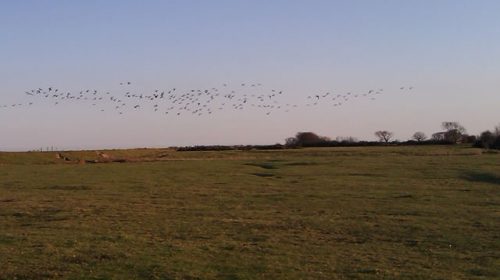Northney Farm mainly consists of pasture land for the grazing of the cows and young stock and making sileage to feed the cows in the winter. Maize is also grown as a forage crop for cattle. It grows tall, straight and in tight rows like a location from The X Files! At harvest time, the whole plant, cob and all, gets combined in one go. The machine chops them into rough chippings that will be stored and fed to cows in winter.

Crop rotation is an important part of farming and our sister farm, Stoke Fruit Farm, uses some of our fields to grow wheat, potatoes and peas.
Crop rotation works like this: In year one a main crop of wheat is sown. In year two a 2nd crop of wheat is grown, although the yield will be less second time round. In year three a break crop of Peas, Potatoes or Maize is grown. In year four wheat makes a comeback and in year five the field is either left as set aside or another break crop is grown. The soil in the north of Hayling is extremely favourable for crops. It is a deep brick earth and regarded as ‘early’ a term which means that crops can be planted in the soil sooner than in areas where the soil is cold and wet.
A significant part of the work of Northney Farm falls within the High Level Stewardship (HLS) Scheme. Electing to work within the remit of HLS was voluntary but considered important because the farm wanted to maintain field boundaries, plant hedgerows, pollen and nectar mixes and allow ditches to grow wild for longer than normal. This effort improves the wildlife on the farm.
Reducing the intensity of farming and helping wildlife improve is a government sponsored scheme aimed at preserving, maintaining and encouraging wildlife to thrive in the countryside. You may have noticed a 2 metre wide uncultivated strip around many of the farm fields. These are left to encourage wild flowers, insects and ground nesting birds to flourish. Ladybirds, skylarks and butterflies are all benefiting from this initiative. Hedge rows are grown and maintained to provide further habitats and cover for wildlife. Cereal stubble is left in the fields after harvest for birds to forage in.

The marshlands bordering the harbour on both the north-east and north-west of the farm are designated Sites of Special Scientific Interest (SSSI). These areas are looked after by the farm. They dig and maintain ditches so that rain water can flow back to the sea at low tide. Across Hayling, flooding is an ever present danger and the maintenance of ditches to allow rain water to return to the sea is crucial.
Much of the SSSI area is out of bounds to the public in the interest of the wildlife that live and breed there. However, Northney Farm has created a walk especially for people to enjoy a section of the marshland and coastline overlooking Langstone and Chichester harbours. (See maps for details).
As well as this walk, there are a number of footpaths across the farm which many people use and gain pleasure from. We are delighted that people enjoy these access routes, but please follow the country code when using them. Shut gates and keep dogs on leads where livestock are grazing. Do not light fires, drop litter, damage fences, trees, crops or farm property. Please do not walk across fields when crops are growing. Keep to the designated footpaths. (See maps for details).
The list of wildlife that enjoy the farmland is endless and includes pheasant, foxes, deer, woodpeckers, bats and many more. We trust that all who walk around the farm consider the impact of their presence on these species.
In all that the farm does, we always give careful consideration to conservation. For example, the use of crop sprays is not arbitrary and while the farm is not organic, much of our work is concerned with recycling and preserving the environment. For example, dung from the cowsheds is ploughed back into the fields to feed the new crops, crops which in many cases are fed back to the cows. One regulation that we have to bear in mind though is that dung can be piled in the fields during winter, but we are only able to plough it in after February 14th, St. Valentines Day, regardless of whether the weather might be favourable for us to plough it in sooner!

